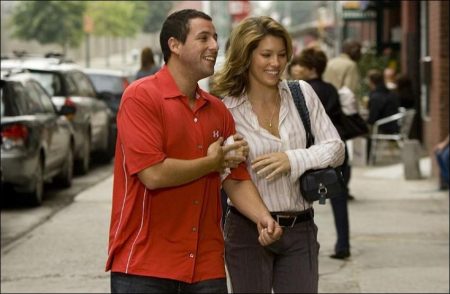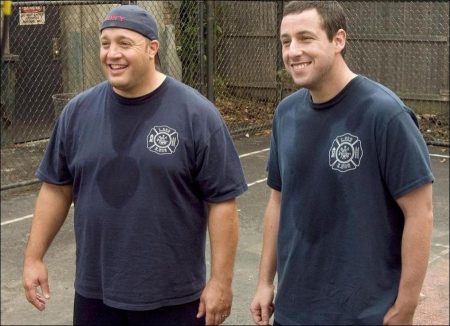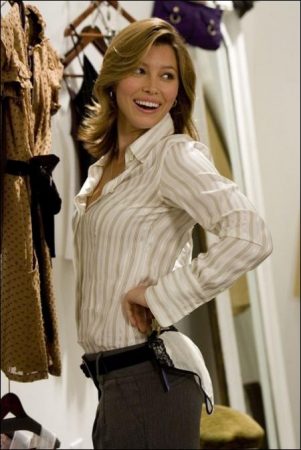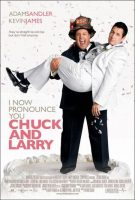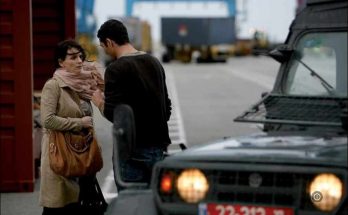Tagline: They’re as straight as can be, but don’t tell anyone.
I Now Pronounce You Chuck and Larry. Chuck Levine and Larry Valentine are friends and Brooklyn firefighting partners. Widower Larry, who still mourns the death of his wife Paula, is having problems changing the beneficiary on his insurance policy from Paula’s name to his children’s. He is worried about his children’s future if he were to be killed in the line of duty, and is contemplating quitting his job for something less risky, but he also does not want to forfeit his firefighter’s pension as he also see it as a safety net for his children. Larry saves Chuck’s life on one of their calls.
So when Chuck tells Larry that he owes him one, Larry takes him up on his offer. Larry’s favor: despite both being heterosexual, that they enter into a domestic partnership, in name and paper only, to provide that much needed protection for Larry’s children. Chronic womanizer Chuck reluctantly but eventually agrees. The one person who knows for a certainty that they are both straight is their boss, Captain Phineas J. Tucker. Their plan hits a snag when Larry believes that they are being investigated by the pension department for possible fraud, which means that Chuck has to move in with him and his kids. They consult the advice of a lawyer, Alex McDonough, who adds an extra layer of complexity to the situation as Chuck in particular is attracted to her and believes she could be the one and only for him. Her legal advice coupled with her wanting Chuck to be her new best girlfriend makes it even harder on him.
I Now Pronounce You Chuck & Larry is a 2007 American comedy film directed by Dennis Dugan. It stars Adam Sandler and Kevin James as the title characters Chuck and Larry, respectively. The film was released in the United States on July 20, 2007.
Chuck & Larry grossed $34,233,750 and ranked #1 at the domestic box office in its opening weekend, higher than the other opening wide release that weekend, Hairspray, and the previous weekend’s #1 film, Harry Potter and the Order of the Phoenix.[14] By the end of its run, the film had grossed $120,059,556 domestically and $66,012,658 internationally for a worldwide total of $186,072,214.
How Far Would You Go for a Friend? Chuck & Larry is Greenlit
The script for I Now Pronounce You Chuck & Larry has had a lengthy history in Hollywood. Comedy director/producer Tom Shadyac and his production partner, Michael Bostick, of Shady Acres Entertainment developed the story and the script a decade ago with legendary comedy writer Barry Fanaro. Over the years, Shady Acres had supervised multiple treatments of the script with varied comic actors in discussions to play the well-intended con men. But they just hadn’t found the right comedy duo to give life to their Chuck and Larry.
After bringing the script to Adam Sandler and his production partner at Happy Madison, Jack Giarraputo, the filmmakers knew that Chuck & Larry finally had found the right home. With revisions to Fanaro’s script by the Oscar-winning writing team of Alexander Payne and Jim Taylor, the story of two bumbling, good-hearted firefighters would soon be ready for production.
Sandler responded to the character of womanizing firefighter Chuck Levine, who is forced to grow up when it comes time to help his best friend out of a tough situation. He enjoyed the script’s humor and was interested in having actor Kevin James play his comedy partner on screen, Larry Valentine. The actor/producer, who has for years shown comedians of every stripe in his films, agreed to star in and produce the comedy. Of his interest in the project, Sandler notes, “I loved the fact that this film was about how far you would you go for a friend… and that these two guys would do anything for each other.”
James related to his character, Larry, because “Larry is a family man who is most concerned with the well-being of his kids.” James also responded to the bond between the title characters. “At the end of the day, this film is about friendship and how these two guys really look out for one another,” he comments. “I was unbelievably happy when Adam called and wanted me to do this movie with him.”
Shady Acres was sold on the idea of Sandler and James in the film, and Universal Pictures gave it the greenlight. The producers would look to their longtime partner, comedy director Dennis Dugan, to helm the project. Dugan has worked with Sandler and Giarraputo on films from Happy Gilmore to Big Daddy, and he most recently directed Happy Madison’s The Benchwarmers, starring Sandler favorites David Spade and Rob Schneider, as well as Jon Heder.
Dugan offers, “This is our fourth movie together—we’ve taken a long road together over the past 10 years. Working as a director with Adam, you see he’s not just an actor for hire, a guy with a vanity company. He’s a real filmmaker. He writes, produces, develops; he’s in the editing room and on the music.”
To complete the backbone of Chuck & Larry’s team, the filmmakers would surround themselves with a crew of familiar faces, including some longtime partners: Academy Award-winning cinematographer Dean Semler, costume designer Ellen Lutter, production designer Perry Andelin Blake and editor Jeff Gourson—all who had worked with Happy Madison on the company’s previous two productions, Click and The Longest Yard.
With the production team and the title characters in place, Dugan and the producers would begin the process of casting friends, family and a host of Saturday Night Live alumni to bring Chuck and Larry’s world to life.
The Adam Sandler Players: Casting Brooklyn’s Funniest
While he is often known to bring back audience favorites from his previous comedies, for I Now Pronounce You Chuck & Larry, Sandler, along with the other producers and director Dugan, would look to a woman who had played roles as varied as a pastor’s daughter, an elite fighter pilot and a vampire hunter. Jessica Biel, fresh off her critically acclaimed turn in 2006’s The Illusionist, came aboard to play Alex McDonough, the attorney the two firefighters hire to represent them against the fraud charges filed by the city of New York. Biel was attracted to this character, whom she read as “an extremely smart gay-rights advocate, a humanitarian who simply wants equality for everybody.”
Biel explains how she got involved with the film: “I’ve always been a fan of Adam’s, but I initially had a tough time breaking into the comedy world, as I have done different genres in the past.” For the director, it was an easy choice.
Dugan offers, “She’s so cool—the most professional, kind, prepared, wonderful, extremely beautiful girl you could ever imagine working with. She moved so easily from The Illusionist to doing this crazed comedy.”
The fellow firefighters of Engine 506 / Ladder 223 were a mix of Sandler repertory members and favorites. When the actor/producer discussed with the team who would be the most appropriate captain for a crew of lovable knuckleheads, they came to the logical decision: It had to be legendary comedian Dan Aykroyd.
For the actor, working with Sandler would be a repeat performance. “I was a big fan of Adam on Saturday Night Live. We’ve only done two films together before (Coneheads, 50 First Dates), but I hope, as time goes on, he will think of me as one of his regular players.”
Aykroyd describes Captain Tucker as “Chuck and Larry’s commanding officer who is placed in an extremely awkward situation. He wants the best for his men, but he realizes that these two guys are up to something where they can get into a lot of trouble, and he might be culpable as well.”
Under Captain Tucker’s command were Chuck and Larry’s fellow crew members, who—in addition to their questions about the allegedly gay couple—had some secrets of their own. The fellow company members include Kevin James’ real-life brother, comic Gary Valentine as suspicious Karl Eisendorf; Jonathan Loughran as clueless Nootzie; Michael Buscemi (brother of Steve) as tough guy Higgy; Nicholas Turturro as slightly crazy, narcissist Renaldo Pinera; JD Donaruma as initially homophobic J.D.; and Peter Dante as jokester Tony Paroni. But it was the newest member of the truck company who would get the most raised eyebrows—the extremely tough and mysterious transfer Fred Duncan, played by Ving Rhames.
Rhames describes his character as “very masculine, heroic and a tough guy.” What he liked about Duncan was that the character offered him the chance to work in a “film that says something about the human experience, the human condition. I think even though this is a comedy, it is very poignant and it says something about society and how people are stereotyped.”
Dugan surmises, “There’s nobody bigger and scarier than Ving, but when he comes on the set, you find he really is a fierce actor who is surprisingly funny. Similarly, Duncan is mysterious and really scary, but it’s a surprise that he’s this sweet, wonderful guy.”
Veteran character actor Steve Buscemi joined the team to play Clint Fitzer, who works in the investigation unit on insurance claims for the city of New York. He’s quite suspicious of this marriage between two firefighters who he believes are not really gay, and he makes it his mission to uncover their fraud.
Buscemi was interested in the project on two levels. Not only did the actor respond to the opportunity to tell an important story in a comic way, he was actually a firefighter for the Fire Department of New York (FDNY) for a time in the ’90s. Saturday Night Live (SNL) alumni would naturally be woven throughout the story. Rachel Dratch plays the man-hungry, flirtatious city benefits supervisor, and writer Robert Smigel cameos as Larry’s suggestive mailman. Sandler go-to guy David Spade makes an appearance as a sassy firefighter booster, and frequent co-star Rob Schneider steals his scenes as the lovable minister Morris Takechi.
SNL stars weren’t the only entertainers Sandler brought on board. Dave Matthews and Lance Bass appear in brief cameos in the film, while comic character actors Nick Swardson and Mary Pat Gleason appear as, respectively, Alex’s overcaffeinated activist brother, Kevin, and Larry’s oversexed, under-worked housekeeper, Teresa. Newcomers Cole Morgan and Shelby Adamowsky play Larry’s kids, Eric and Tori. And Richard Chamberlain provides some thoughtful counsel as the head of the board to which Chuck and Larry make their legal plea.
Finally, the filmmakers cast a number of actual firefighters for the film. Dugan relates: “We needed real firefighters to drive the trucks. For example, we had a tiller truck—with a guy steering in the back—that is not easy to drive. We needed those kinds of specific skills, and we knew it would be good to have real guys to round out our experience.”
Dugan had his work cut out for him in directing such an accomplished cast of actors and curious newcomers. However, as a former actor, he made sure that his set was ready to deal with the nerves talent can have when performing in such a big production. One simple way to shake off tension was to allow for improvisation. Sandler and James brought many of their own jokes to the work of Fanaro, Payne and Taylor. Of similar mind when it came to ad-libbing, Dugan relates: “When getting the best actors, you’re stupid not to let them ad-lib. These people are really funny. For example, Aykroyd would say, ‘What if I said this here?’ and we would try it. In the end, if it’s funny, it doesn’t matter who thought it up.”
Hose Packs and SCBAs: Firefighter Training
As research for their roles as New York City firefighters, Sandler, James and their fellow firefighter actors spent several days in the summer heat at a modified drill tower in the Inglewood Fire Academy in Southern California. There, they worked with firefighters from the El Camino Fire Department to perfect their hose lays, chopping technique and search-and-rescue skills. Relates director Dugan, “We sent all the guys through fire training—actual facilities—and we had real firemen as part of our fire squad.”
The film’s fire consultant, Terry Quinn, currently serves as a FDNY firefighter and also oversees FX’s successful drama series Rescue Me. Quinn flew to Los Angeles to handle the training of the actors, so they could experience how FDNY firefighters fight actual fires and conduct daily station operations.
As imagined, scheduling the pyrotechnics and shooting the fire scenes were a tremendous undertaking and required precise skills from all cast and crew involved. During photography preparation, Dugan asked Quinn to walk his team through the basic steps and principles, as well as the technical aspects of the job and what life is really like in the firehouse.
Quinn taught the “boots” (rookie firefighters) the correct methods to put on their turnouts, strap on helmets, use the masks for compressed air and climb aboard their respective engine or truck. Lingo, basic emergency medical techniques and station protocol were all covered. The new firefighters were taught the correct maneuvers for climbing ladders and dismounting the engine as they approached a fire and prepared to lay hose. Because Chuck and Larry are on the truck, Sandler and James learned the basics of laddering, ventilation and rescue. They also got a taste of engine life, studying up on how to operate the hoses.
For James, it was exciting to live out a boyhood fantasy. He notes, “Just putting on the gear and riding on the truck gave me such great respect for what these guys do every day.”
In a simulation, Sandler and fellow company man Peter Dante were allowed to enter an extremely hot room and use extinguishers to put out couches set through a diesel-fuel fire. Dante recalls, “Terry trained us NY style, meaning New York City firefighters go into the fire and fight from the inside out (as opposed to a surround-anddrown technique smaller cities sometimes favor). As we went on, we realized how dangerous their jobs are and how important every technical move is to staying alive.”
East Coast-based Aykroyd had his own training, and went to a facility that the Greenpoint, Long Island, Fire Department operates. He remembers, “They put us in full pack and gear, and it’s extremely heavy. It is about 70 lbs. with the coat, the pants, the suspenders, the pick, the hook, the rope, the flashlight and the walkie-talkie. It immediately makes you appreciate how heroic firefighters are.”
The Ideal Firehouse: Engine 280 / Ladder 132
When deciding where to film the firehouse in which the good-hearted cons live and work in Chuck & Larry, there was no option but to lens those scenes in New York City. The filmmakers began their search for the perfect firehouse to use over the course of production, and found it at FDNY’s Engine 280/Ladder 132—built in 1912 and located in Prospect Heights, Brooklyn. For the production, the house would be known as Engine 506/Ladder 223.
Dugan offers, “We wanted the firehouse to be organic to the story, so we drove for weeks around Brooklyn before picking this neighborhood.”
Of the research and shooting, Dugan notes, “I spent time in this Brooklyn firehouse around the clock, photographing and talking to the guys. Firemen form a very dark-humor fraternity clan. It was really fun, even at 4:00 a.m. in the morning when they were busting each others’ balls.”
The film’s production designer and 2nd unit director, Perry Andelin Blake, explains why they chose the firehouse in Prospect Heights to shoot the film. “We were excited when we found it, because it had so much history, wear and tear and living,” he remembers. “We really wanted to try to capture that in our set.”
While in Brooklyn, the filmmakers used the interior of the fire station’s first floor for shots of the guys sliding down the fire poles and suiting up to go on a run. They shot the exterior of the fire station to catch the engine and the truck racing out calls. After 9/11, the firefighters had a logo painted across their firehouse doors, emblazoned with the words “In the Eye of the Storm,” reflecting exactly how they felt.
What firefighter film would be complete without the heroes sliding down the pole the minute the house alarm goes off? Keeping with tradition, Sandler, James and Aykroyd slid down multiple times for key scenes. James laughs, “They say the secret is to wrap your shirt around your hand. If you just go with your hands and legs, you’re going to burn all the way down.”
The 85-year-old station also allowed cinematographer Dean Semler multiple shots of the truck and engine as they came out of the garage, and to catch depth down the streets and establish the neighborhood. To get the flavor of Brooklyn, Semler shot a number of sequences with the guys driving down streets on the truck.
Shooting in this part of Brooklyn gave the crew the chance to film high above the city, where they would capture terrific views of midtown. During one scene in which Chuck and Larry try to extricate a criminal stuck in a ventilation shaft (and have one of many marital arguments), the cameras were able to sweep views of the Empire State Building, the Chrysler Building and the entire area.
For the living-space interior of the firehouse, the production built a set on a backlot stage at Sony Pictures. The set included the kitchen and dining area, workout room, shower room and lounge area. Based on the Brooklyn firehouse where they shot exteriors, the designers used old woods, bricks and the idiosyncrasies endemic to a fire/frat house that would make it feel true to life. Blake notes, “We made sure it felt plenty lived-in, and there were a lot of their personal effects all over. It really wasn’t super clean, but it represented how they lived.”
The production designer describes how the actual New York firefighters cast in the comedy reacted when they walked onto the L.A. set for the first time. “They were blown away,” he recalls. “They said, ‘You got it. This really feels like the firehouses where we live, where we’ve spent time.’”
Additional Sets and Locations: Chuck and Larry’s Homes
Some of the biggest comedy moments in I Now Pronounce You Chuck & Larry come from the extremely awkward move-in of Chuck, from his bachelor pad to the family home Larry shares with his young children. The exteriors of the Valentine home were shot in a small neighborhood in Brooklyn near the Arizona Bridge, a place full of simple brick homes built after World War II. With friendly neighbors and big sycamore trees in front yards, the different-colored awnings prove one of the few ways passersby can distinguish the homes. The area is every bit the blue-collar community in which a New York City firefighter would live.
When Dugan and company created Larry’s house for interior shots, they wanted to give the Valentines a home with a backyard. Because it was a set and not an actual home, they didn’t have to pull structural walls out to get impossible shots of the family. The interior in Larry’s house would definitely have to have a woman’s touch, reflective of his late wife’s presence in the home. For comic relief, this was especially true in Larry’s bedroom. When Chuck lies down in the bed with Larry for the first time, it was crucial for the comedy that he definitely feel as uncomfortable as possible.
In Chuck’s apartment, the filmmakers wanted to create a “swinging pad,” according to production designer Blake. His team designed a basement-type space with high windows that would give the feel of a bachelor’s joint that should have a revolving bedroom door. Though Chuck is every bit the ladies’ man, he is quite out of date in his selection of colors and styles for his decor. The production used ’80s- and ’90s-style grays and blacks, and a black-and-white checkerboard counter to complete the cheesy look.
Church Raves and Wedding Chapels
To lens the AIDS benefit/costume party to which attorney Alex invites Chuck and Larry, the filmmakers found an old church in downtown Los Angeles, St. Vibiana’s. When the firefighters arrive at the benefit, they could not be bigger fish out of water. The interior of the former church was redecorated in a crazy rave fashion—with bright colors, loud music, and pulsing lights and sounds emitting from every window or speaker. The bombardment of people and projections created a set that constantly dazzled and disturbed the guys, new to the gay dance life.
In addition to creating the authentic style New York firefighter uniforms emblazoned with the FDNY crest, costumer Ellen Lutter sewed over-the-top costumes for Chuck and Larry’s debut as new gays. For Kevin James, she designed a giant apple outfit in which he could jam, while Adam Sandler was a roving vampire trying to resist his urges to hit on a feline Jessica Biel.
Morris Takechi’s Two Hearts Wedding Chapel was designed to feel like a quickie marriage joint one might find in Niagara Falls (to which the guys run for their ceremony)—small and rather tacky. The character of Chuck would assuredly want something in the middle of nowhere, so the story of his nuptials could never get back to anyone he knew. The filmmakers found that church in the Chapel of Roses in Pasadena—a getaway that had exactly the right layout to become Takechi’s Two Hearts.
When looking for the council chambers in which Chuck and Larry must fight for their rights, filmmakers discovered the Bank of America Building in downtown Los Angeles. The city landmark has huge columns and arches in its interior, and it provided great bones for the film’s finale set.
Blake, Dugan and company retrofitted the space to make it look as if the firefighters were entering an older building in Brooklyn in which a new courtroom had been installed. They built a dais for the esteemed council (led by Richard Chamberlain) and added a number of new elements such as translucent panels backlit with blue, with light wood and translucent plastic. That served to give the area a modern look that would distinguish it from a typical stuffy courtroom.
****
Production wrapped, fire gear removed and faked comic romance shelved, the company left I Now Pronounce You Chuck & Larry perhaps a little more sensitive than it had upon entering principal photography. And the question that would stay in the minds of all of them was the one Chuck and Larry had already answered: “How far would you go for a friend?”
I Now Pronounce You Chuck and Larry (2007)
Directed by: Dennis Dugan
Starring: Adam Sandler, Kevin James, Jessica Biel, Ving Rhames, Steve Buscemi, Dan Aykroyd, Nicholas Turturro, Allen Covert, Rachel Dratch, Richard Chamberlain, Mary Pat Gleason
Screenplay by: Lew Gallo, Barry Fanaro, Alexander Payne
Production Design by: Perry Andelin Blake
Cinematography by: Dean Semler
Film Editing by: Jeff Gourson
Costume Design by: Ellen Lutter
Set Decoration by: Susan Bode, Gary Fettis
Art Direction by: Alan Au, David Swayze
Music by: Rupert Gregson-Williams
MPAA Rating: R for some crude sexual humor and nudity.
Distributed by: Universal Pictures
Release Date: July 20, 2007
Views: 71
